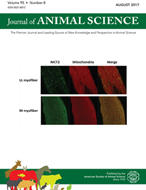-
Views
-
Cite
Cite
D. R. Ames, D. R. Brink, C. L. Willms, Adjusting Protein in Feedlot Diets during Thermal Stress, Journal of Animal Science, Volume 50, Issue 1, January 1980, Pages 1–6, https://doi.org/10.2527/jas1980.5011
Close - Share Icon Share
Summary
When feedlot animals are exposed to thermal stress (hot or cold) average daily gain (ADG) is lowered and gross efficiency of converting nutrients to tissue is reduced. The basis for these observations is increased maintenance energy requirement which reduces energy available for growth. If protein is fed as a constant percentage of the diet then during thermal stress protein content of the diet increases per unit of energy available for growth. Reduced growth rate combined with constant protein intake lowers protein efficiency ratio (PER). It was hypothesized that adjusting protein intake during thermal stress in proportion of expected reduction in ADG would increase PER without further reduction in ADG. In trials with both lambs and cattle fed during both, cold and heat, the hypothesis was substantiated. Therefore, under practical conditions, protein adjustment during thermal stress will improve PER and inturn reduce feed cost per unit gain as a function of the difference between cost of dietary protein and energy.





